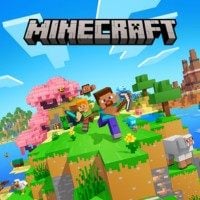Minecraft: Blocks - types, features
Blocks - types, features: basic building blocks, gravel and sand, liquids, resources and minerals, plants - uses, tips; where to find?
This page of our Minecraft guide has information about blocks, their types and properties.
Basic building blocks

The basic blocks that comprise this world are rocks (after being collected, they turn into cobblestone), dirt and sand. Dirt and sand, as building materials of low hardness are the fastest to obtain, using the spade, and rocks using the pickaxe. Basic blocks are not subject to laws of physics (like gravity or water absorption).
Dirt is used as an element of cultivation, for most plants, and it is only there that they can be grown. It is common enough to be worthless for bartering.
Among rocks you can find, virtually, all materials. It is the most common in the entire game. After you burn it, it becomes smooth and nice for the eye, but it changes completely its properties, from the point of view of recipes - it becomes a stone instead of cobblestone.
In sand you can find clay and this is the only place where you can find it. Apart from deserts, sand can also be found at the bottom of water reservoirs and, often, at the shore. It can be found together with sandstone, whose hardness is higher and it behaves just like the other building blocks in the game. Still, sand is useful, because if you put it into the furnace you get glass and it is the only ground to grow cacti and sugar cane.
Gravel and Sand

These are blocks of specific properties - they are subject to gravity. When a block under sand or gravel is removed, the block above falls into the space that used to be occupied by the one below. If one such block falls onto your character, it squashes him. This kind of objects can often be used to build traps.
Liquids

In the game, there are only two liquids - water and lava. If combined, they turn into stone (if lava makes it way to water) or obsidian (if water makes its way into the source of lava). Both of them obstruct movement. While flowing, lava sets on fire everything in its way, it flows slower than water and can also be used as source of light.
Water can be used for transporting blocks of natural resources (if properly guided), it can be used to put out fire and to cushion falls. You can move up water vertically. In water, you can drown, which is why you should not stay in it for too long.
Resources and minerals

All of the resources and minerals are, unlike the rest of the blocks, less common. Depending on the type, they can be found at various altitudes with varying probability. They stand out with their looks and they resemble stone with colorful spots. They also have varying extents of hardness, e.g. diamonds cannot be obtained with a stone pickaxe.
Plants

In Minecraft there are various plants, of which trees are the most important. There are different species and sizes of the individual specimen, and also there are leaves distributed at random. Among tree leaves, you can find apples. Blocks of wood, as a material, do not influence the item that is crafted.
In the game, there also are mushrooms that are used as food and ingredients in various recipes. Apart from them, there is a plethora of decorative plants and food plants, like e.g. wheat or cacti. Flowers also are useful in the game - you can use them as dyes.
You are not permitted to copy any image, text or info from this page. This site is not associated with and/or endorsed by the developers and the publishers. All logos and images are copyrighted by their respective owners.
Copyright © 2000 - 2025 Webedia Polska SA for gamepressure.com, unofficial game guides, walkthroughs, secrets, game tips, maps & strategies for top games.
